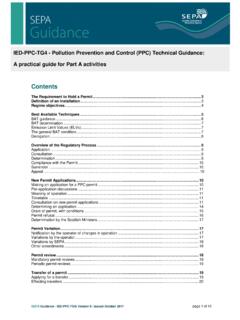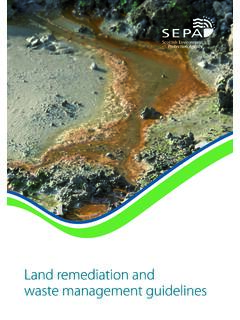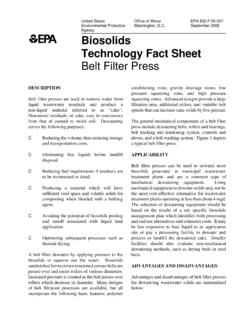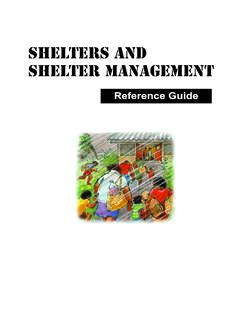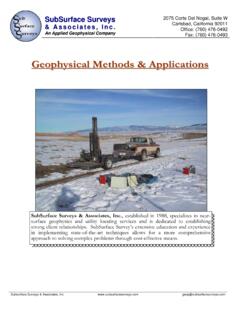Transcription of Land use vulnerability guidance
1 UPS-BP-GU2a UNCONTROLLED DOCUMENT WHEN PRINTED Page 1 of 7 Flood Risk and land Use vulnerability guidance LUPS-GU24 UNCONTROLLDED DOCUMENT WHEN PRINTED Page 2 of 7 SEPA Flood Risk and land Use vulnerability guidance SCOTTISH ENVIRONMENT PROTECTION AGENCY Identifier: LUPS-GU24 land Use Planning System SEPA guidance Pages: 7 Issue no: Version 4 Issue date: 10 July 2018 Flood Risk and land Use vulnerability guidance Update Summary Version Description Version 1 First issue 2012 Version 2 Second issue August 2017 document shortened to remove repetition, and textual changes made to align document with Scottish Planning Policy 2014. Version 3 Third issue February 2018 minor amendments made to correct errors in document. Version 4 Fourth issue July 2018 minor amendments made to approach to most vulnerable uses to align with LUPS-BP-GU2a Notes This document provides SEPA guidance on land use planning and flood risk.
2 It is based on SEPA s interpretation of national planning policy and duties and requirements under relevant legislation. This document is uncontrolled if printed. Always refer to the online document for accurate and up-to-date information. LUPS-GU24 UNCONTROLLDED DOCUMENT WHEN PRINTED Page 3 of 7 SEPA Flood Risk and land Use vulnerability guidance Flood risk vulnerability guidance 1 Summary and background The purpose of this guidance is to: aid understanding of the relative vulnerability to flooding of different land uses; assist in the interpretation of SEPA s Flood Risk Planning guidance , which is based upon the risk framework in the Scottish Government s Scottish Planning Policy 2014 (SPP). SEPA has created this guidance to assist in our assessment of the vulnerability to flooding of different types of land use.
3 Table 1 classifies the relative vulnerability of land uses, grouping them into five categories from Most Vulnerable through to Water Compatible Uses. Table 2 of this document then provides a very brief outline of the likely SEPA planning response for each set of land uses relative to the category of flood risk, and based upon the risk framework in SPP. For a more detailed understanding of SEPA s likely planning response to proposals through both the Development Planning and Development Management process, this document must be read in conjunction with our Flood Risk Planning guidance . SEPA will use this guidance in the assessment of sites for both Development Planning and Development Management purposes. This guidance classifies land uses according to how they are impacted by flooding, their relative susceptibility and resilience to flooding, and any wider community impacts caused by their damage or loss.
4 The classification recognises that certain types of development, and the people who use and live in them, are more at risk from flooding than others ( children, the elderly and people with mobility problems that may have more difficulty in escaping fast flowing water). The term land use vulnerability is used in this guidance to differentiate between a range of land uses, taking account of flooding impacts on land uses in terms of their relative susceptibility and resilience to flooding. It also reflects wider community impacts caused by their damage or loss. For example, a police station is not more likely to suffer damage (be susceptible) or less able to recover (be resilient) than a comparable office building. However, it is in a more vulnerable category than an office use because a higher value is placed upon the wider community impacts that would be caused by its potential loss or damage during a flood event.
5 Similar considerations apply to the inclusion of hazardous waste facilities within the highly vulnerable category and other waste treatment facilities being within the less vulnerable category. The classification comprises five categories: 1. Most Vulnerable Uses 2. Highly Vulnerable Uses 3. Least Vulnerable Uses 4. Essential Infrastructure 5. Water Compatible Uses LUPS-GU24 UNCONTROLLDED DOCUMENT WHEN PRINTED Page 4 of 7 SEPA Flood Risk and land Use vulnerability guidance In relation to Table 1, you should note that: The list of uses is neither exhaustive nor definitive. Flood risk management infrastructure, and other risk mitigation actions needed to ensure development is safe, may differ between uses within the same category. The impact of a flood may change in nature relative to the uses within the same category.
6 In particular, a change of use to a dwelling house from other uses within the Highly Vulnerable Uses category could significantly increase the overall flood risk, especially in relation to human health and financial impacts. The classification (Table 1) is linked to the risk framework in SPP by a matrix of flood risk (Table 2). Table 2 gives a very brief outline of SEPA s likely planning response for each of the three flood risk categories of the risk framework relative to each of the five vulnerability categories. In producing this guidance , SEPA has sought to refine and enhance the vulnerability classification and definitions identified in the SPP risk framework. LUPS-GU24 UNCONTROLLDED DOCUMENT WHEN PRINTED Page 5 of 7 SEPA Flood Risk and land Use vulnerability guidance Table 1: SEPA land Use vulnerability Classification1 1.
7 Most Vulnerable Uses For the purpose of this guidance , Most Vulnerable Uses include land uses that are defined as both civil infrastructure and most vulnerable in the SPP 2014 glossary. Civil infrastructure is denoted with an asterisk (*) in the list below. Most Vulnerable Uses therefore comprise: police stations* ambulance stations* fire stations* command centers and telecommunications installations required to be operational during flooding* emergency dispersal points* hospitals* schools* care homes* nurseries residential institutions, prisons, children s homes basement dwellings isolated dwelling(s) in sparsely populated areas dwelling houses situated behind informal embankments2 caravans, mobile homes, chalets and park homes intended for permanent residential use holiday caravan, chalet, and camping sites installations requiring hazardous substance consent (but where there is demonstrable need to locate such installations for bulk storage of materials with port or other similar facilities, or with energy infrastructure, that require a coastal or water-side location, or other high flood risk areas, then the facilities should be classified as Essential Infrastructure see column 4).
8 2. Highly Vulnerable Uses Comprise: buildings used for dwelling houses social services homes (ambulant /adult) hostels and hotels student halls of residence non-residential uses for health service landfill and sites used for waste management facilities for hazardous waste 3. Least Vulnerable Uses Comprise: shops financial, professional, and other services restaurants and caf s hot-food takeaways drinking establishments nightclubs offices general industry storage and distribution non-residential institutions not included in Most Vulnerable or Highly Vulnerable Uses assembly and leisure land and buildings used for agriculture and forestry that are subject to planning control waste treatment (except landfill and hazardous waste facilities) minerals working and processing (except for sand and gravel) 4.
9 Essential Infrastructure Comprises: essential transport infrastructure (including mass evacuation routes) that has to cross the area at risk essential utility infrastructure that has to be located in a flood risk area for operational reasons (this includes electricity generating power stations and grid and primary sub-stations, sewage treatment plants and water treatment works, wind turbines and other energy generating technologies) installations requiring hazardous substance consent only where there is demonstrable need to locate such installations for the bulk storage of materials with port or other similar facilities, or with energy infrastructure that requires a coastal, water-side, or other high flood risk area location. 5. Water Compatible Uses3 Comprise: flood control infrastructure environmental monitoring stations water transmission infrastructure and pumping stations sewage transmission infrastructure and pumping stations sand and gravel workings docks, marinas and wharves navigation facilities MOD defence installations ship building, repairing, and dismantling dockside fish processing and refrigeration and compatible activities requiring a waterside location water-based recreation (excluding sleeping accommodation)
10 Lifeguard and coastguard stations amenity open space nature conservation and biodiversity outdoor sports and recreation and essential facilities such as changing rooms essential ancillary sleeping or residential accommodation for staff required by uses in this category, subject to a specific operational warning4 and evacuation plan. 1 Developments that combine a mixture of uses should be placed in the higher of the relevant classes of flood risk vulnerability . The impact of a flood on the particular land use could vary within each vulnerability class. In particular, a change of use to a dwelling house within the Highly Vulnerable category could significantly increase the overall flood risk, especially in relation to human health and financial impacts.






